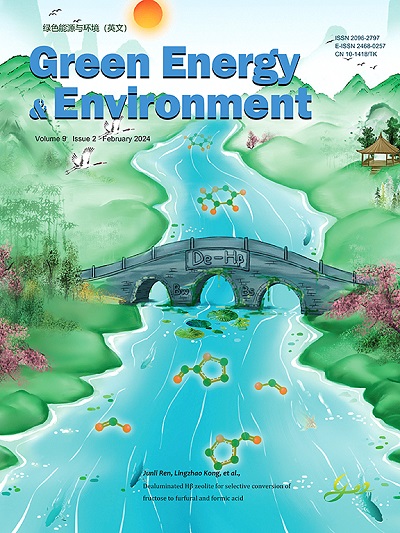Spatially confined synthesis of TiNb2O7 quantum dots onto mesoporous carbon and Ti3C2TX MXene for boosting lithium storage
IF 10.7
1区 工程技术
Q1 CHEMISTRY, PHYSICAL
引用次数: 0
Abstract
TiNbO has been emerged as one of the most promising electrode materials for high-energy lithium-ion batteries. However, limited by the slow electron/ion transport kinetics, and insufficient active sites in the bulk structure, the TiNbO electrode still suffers from unsatisfactory lithium storage performance. Herein, we demonstrate a spatially confined strategy toward a novel TiNbO-NMC/MXene composite through a triblock copolymer-directed one-pot solvothermal route, where TiNbO quantum dots with a particle size of 2-3 nm are evenly embedded into N-doped mesoporous carbon (NMC) and TiCT MXene. Impressively, the as-prepared TiNbO-NMC/MXene anode exhibits a high reversible capacity (486.2 mAh g at 0.1 A g after 100 cycles) and long cycle lifespan (363.4 mAh g at 1 A g after 500 cycles). Both experimental and theorical results further demonstrate that such a superior lithium storage performance is mainly ascribed to the synergistic effect among 0D TiNbO quantum dots, 2D TiCT MXene nanosheets, and N-doped mesoporous carbon. The strategy presented also opens up new horizon for space-confined preparation of high-performance electrode materials.在介孔碳和 Ti3C2TX MXene 上空间约束合成 TiNb2O7 量子点以提高锂存储能力
TiNbO 已成为高能锂离子电池最有前途的电极材料之一。然而,受限于缓慢的电子/离子传输动力学以及块体结构中活性位点的不足,TiNbO 电极的锂存储性能仍然不尽如人意。在本文中,我们通过三嵌段共聚物引导的一锅溶热路线,展示了一种新型 TiNbO-NMC/MXene 复合材料的空间限制策略,即将粒径为 2-3 纳米的 TiNbO 量子点均匀地嵌入 N 掺杂介孔碳(NMC)和 TiCT MXene 中。令人印象深刻的是,制备的 TiNbO-NMC/MXene 阳极具有高可逆容量(100 次循环后,0.1 A g 时为 486.2 mAh g)和长循环寿命(500 次循环后,1 A g 时为 363.4 mAh g)。实验和理论结果进一步证明,如此优异的锂存储性能主要归功于 0D TiNbO 量子点、2D TiCT MXene 纳米片和掺杂 N 的介孔碳之间的协同效应。所提出的策略也为高性能电极材料的空间封闭制备开辟了新天地。
本文章由计算机程序翻译,如有差异,请以英文原文为准。
求助全文
约1分钟内获得全文
求助全文
来源期刊

Green Energy & Environment
Energy-Renewable Energy, Sustainability and the Environment
CiteScore
16.80
自引率
3.80%
发文量
332
审稿时长
12 days
期刊介绍:
Green Energy & Environment (GEE) is an internationally recognized journal that undergoes a rigorous peer-review process. It focuses on interdisciplinary research related to green energy and the environment, covering a wide range of topics including biofuel and bioenergy, energy storage and networks, catalysis for sustainable processes, and materials for energy and the environment. GEE has a broad scope and encourages the submission of original and innovative research in both fundamental and engineering fields. Additionally, GEE serves as a platform for discussions, summaries, reviews, and previews of the impact of green energy on the eco-environment.
 求助内容:
求助内容: 应助结果提醒方式:
应助结果提醒方式:


